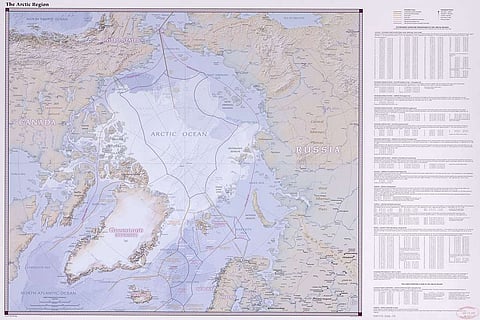

The Arctic in the 21st century has emerged as the newest frontier in global competition between nation-states. As melting ice and climate change expose untapped natural resources, and shifting geopolitical dynamics take hold, the race for control and access in the Arctic is poised to define the coming decades.
Arctic and even non-Arctic nations, multinational corporations, and non-state actors are all vying for a stake. The stakes are high—vast reserves of oil, gas, and minerals, the potential for new maritime trade routes, and critical military vantage points. In an increasingly chaotic world, access to the Arctic could be the difference between geopolitical relevance and stagnation.
The region is warming at four times the global average due to a phenomenon known as polar amplification. Since 1979, Arctic sea ice has declined by 13% per decade. Some climate models predict that the Arctic Ocean could be ice-free during summer months as early as the 2030s. While this spells disaster for polar ecosystems, it opens the door to new commercial opportunities. Formerly inaccessible regions may soon become resource-rich zones for those bold enough to venture in.
One of the most tantalizing prospects is the Northern Sea Route (NSR), which runs along the Russian coast and through the Canadian Arctic Archipelago. This route could significantly shorten shipping distances between Asia, Europe, and North America—far more than the Suez or Panama Canals. Trials have shown that transit time between Shanghai and Rotterdam could be reduced by up to 40%, translating into major savings. However, harsh ice conditions, limited infrastructure, and high insurance costs currently limit the route’s commercial viability.
The economic allure is undeniable. The Arctic is believed to hold 13% of the world’s undiscovered oil, 30% of its undiscovered natural gas, and vast reserves of rare earth minerals. These resources make it one of the most strategically significant regions on Earth.
For Russia, the Arctic represents a monumental opportunity. With control over nearly half the Arctic coastline, it has taken the lead in resource extraction and infrastructure development. State enterprises like Gazprom and Rosneft have already seen successes, such as the Yamal LNG plant. Other active players include Norway, with its Barents Sea oil and gas projects, along with Canada, Denmark, and the United States. Even China, a non-Arctic country, has positioned itself as a major stakeholder.
Russia’s long Arctic coastline has necessitated a significant investment in icebreakers, ports, and navigation systems to support the NSR. China, meanwhile, has declared itself a “near-Arctic state” and invested in the NSR as part of its broader Belt and Road Initiative—expanding it into what is now dubbed the “Polar Silk Road.” Chinese mineral companies have also made notable inroads in Greenland.
Complicating matters is the fractured state of the Arctic Council. With tensions high and member states unable to agree on coherent policies, the council is struggling to maintain its role as a stabilizing forum. Meanwhile, the militarization of the Arctic continues. Russia has prioritized Arctic security, reopening Soviet-era bases and deploying advanced radar systems, S-400 air defenses, and hypersonic weapons along its northern frontier. Moscow sees the region as both a shield against NATO and an economic lifeline—particularly amid sanctions that have pushed it closer to China.
On the other side, NATO has expanded its presence in the Arctic, with military exercises in Alaska and Greenland, and the recent accession of Finland and Sweden further strengthening its cold-weather capabilities. However, NATO’s Arctic strategy remains fragmented and underdeveloped.
China’s 2018 Arctic Policy emphasizes scientific research and environmental protection, but its rapid construction of dual-use infrastructure has raised alarm in the West. Buildings that may serve both civilian and military purposes are a source of growing concern, contributing to a climate of mistrust that could lead to escalation.
Of course, geopolitical ambition comes at a cost. The environmental toll is already significant. Resource extraction and increased shipping traffic threaten the region’s fragile ecosystems. The International Maritime Organization’s Polar Code, adopted in 2017 to regulate Arctic navigation and protect the environment, exists in theory—but its enforcement remains inconsistent.
Indigenous communities—numbering around half a million and including the Inuit, Sámi, and Athabascans—have expressed concern about the industrial projects disrupting traditional ways of life such as hunting and fishing. While some have found new economic opportunities, others view these changes as a threat to their culture and autonomy. In many cases, they have little say in what happens on their ancestral lands.
The race to the Arctic will bring both positive and negative consequences. But one thing is certain—it is accelerating, and the key players are becoming increasingly determined.